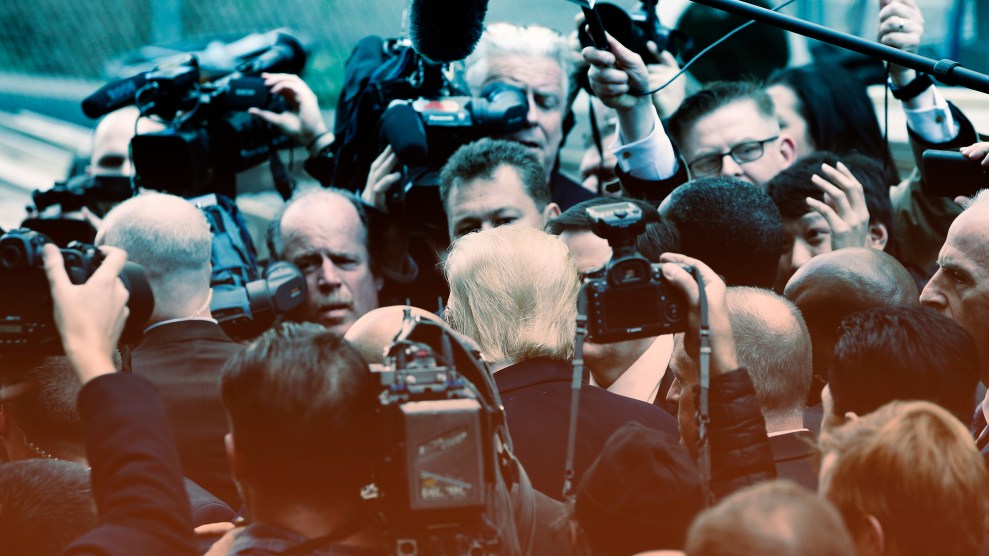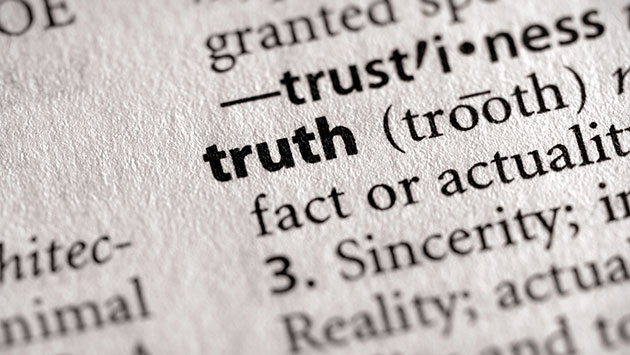So, reader, have you been following less news lately? God, I hope so.
I’m not supposed to say that. Not as a journalist. Not as the CEO of Mother Jones, where we strive to connect with a big audience so that our mission-driven reporting can have impact. Reach, eyeballs, ratings—so much of the conventional wisdom about what journalism should aim for revolves around those numbers.
That’s certainly what Donald Trump thought. Remember how he warned that news ratings would “tank if I’m not there”? The truth is, they kind of did. For four years he had Americans glued to screens, lured by fear, schadenfreude, and a spectacle of Keystone Kops authoritarianism that culminated in a violent insurrection—one of the biggest days for TV news ratings, and one of the worst for American democracy.
Now, finally, our collective grip on the remote has relaxed a bit. CNN’s primetime ratings dipped 45 percent from January to February. The New York Times’ traffic declined 17 percent from January; the Washington Post’s 26 percent. Mother Jones’ website audience at the time I write this is down about 40 percent. But I’m going to go out on a limb and say that for people who care about the future of our country and our planet—like all of you in the Mother Jones community—that might be a good thing.
Because consider what was driving that traffic: In the fall, our most-read stories were about QAnon, Rudy Giuliani, Mitch McConnell ramming through a Supreme Court justice, and the Sturgis motorcycle rally setting off as many as 250,000 coronavirus cases—and that was before the president tried to overturn the election. In short, batshit bonkers stuff that it’s hard to believe really happened just a few months ago.
Now we have a president so boring, his worst scandal has been his rescue dog nipping staffers. Slower news days have never felt so good.
But it’s true that the abeyance of batshit bonkers is a problem for the news business. More eyeballs means more advertising (at least the crumbs that Google, Facebook, and Amazon leave behind) and more subscriptions. Even at a nonprofit news organization like Mother Jones, we often get asked: “Are you screwed without Trump?”
Of course that’s an absurd question—a news organization that needs a protofascist showman in power is a news organization that doesn’t deserve to survive. But let’s be real, most people are too busy living their own lives to worry about what news organizations need to survive.
That is my job, and I’ll be honest with you: I’m going to ask you to support our team’s nonprofit journalism as part of this check-in I’m writing today. Don’t sweat it if you can’t or don’t intend to pitch in, but please do read along because after these chaotic few years my aim is also to reset with you about where Mother Jones is and where we’re going—especially for those of you who found our reporting during the batshit years. I want to talk about the “what now” questions we all confront, and hear your thoughts about it all, too (there’s a feedback form at the bottom of this post, and we read every message).
We need to raise $350,000 from our online community by July 17 for reasons you’ll see below. And my hope is that the best legal way to do it is also the one that feels most true to this moment: Write about why MoJo‘s work matters, with the challenges and opportunities ahead, in a way that will outlast the fleeting headlines we’ve all grown used to.
The truth is, 2020 proved that even a deluge of bonkers can’t save the news business. Last year, 16,000 jobs in newsrooms disappeared—and that was on top of 27,000 jobs eliminated over the past decade. And while the pace has slowed a bit in 2021, the cuts are likely to keep coming. They always do. “These media companies are looking at the dollar signs, and it’s just not there,” Joel Kaplan, a journalism professor at Syracuse University, told CNN in the spring. “They have probably six months before it really gets bad.”
Not to argue with a professor, but for many newsrooms, “really bad” has been here for a while. The vulturous Alden Global hedge fund is swallowing up some of the nation’s most storied newspapers (this is awful not just for the journalists who work there, but for all of us as citizens). Outfits from HuffPost to NBC and even public media such as WNYC in New York are cutting staff. Here at Mother Jones, about 60 percent of our team took a pay cut last year as an act of solidarity to avoid layoffs. Right now we’re trying to square our budget that goes into effect July 1 and we’re doing everything we can to avoid having to do that again—any amount you can pitch in helps.
So it’s not that “without Trump, we are screwed.” It’s that we are, forgive the language, screwed with or without him if we can’t show the public that what we do matters for the long term—not just when there’s a pandemic afoot or a despot on the move. We’re screwed if newsrooms that tell it like is can’t find the stable footing—and funding—to keep at it. Chronicling crises is important, but we’re screwed if journalism can’t shine a light on the systemic forces that brought the crises about, and will again unless we make change.
And that’s what Mother Jones has always been here to do. We were founded as a nonprofit in 1976 because in-depth investigative reporting was badly needed and the market wasn’t going to provide it. Two of our biggest early investigations were about how automakers calculated that paying for deaths and injuries was cheaper than fixing fatal design flaws in the now infamous Ford Pinto, and how tobacco companies were trying to snuff out anti-smoking efforts. Do you think car and tobacco companies, then two of the mainstays of magazine advertising, would want their ads to appear next to those exposés? The bet MoJo made was that readers would support journalism about abuses of power, even when power hits back. And for 45 years, you have.
A lot has changed in those four-and-a-half decades, and the speed of change keeps accelerating. So this spring, our newsroom used the post-election moment of slowdown to think hard about our priorities. With around 50 reporters and editors, we’re not big enough to cover everything. But we do have the ability to go deep and stick with a story over time. We asked ourselves: Which stories should we stick with?
What we realized was that many of the most important issues we need to cover now are the same as in the Trump era (and for years before) because the biggest challenges for our world have not changed—they’ve just taken different forms. Exposing corruption; illuminating the fight to defend and expand democracy; advancing racial and economic justice; and grappling with the climate emergency and its solutions. Mother Jones has always stood for reporting that tackles these kinds of big, vital stories.
At one of our staff meetings recently, our editor-in-chief, Clara Jeffery summarized this in a way that resonated with me. “Because Trump did such damage on almost every beat we cover, it seemed like he was what we covered. But in truth he was just an avatar for the racism, the corruption, the sexism, the authoritarian impulses that rallied to him, but that he did not invent.”
An avatar, an apparition that seemed bigger than it actually was—in part because he drove those media ratings and eyeballs. And now that we can take our eyes off Trump a little more easily, it’s important that we not take our eye off the forces that were behind his rise, or the changes that need to happen to prevent the next incarnation.
Here’s an example of what I’m talking about. Allegiance to white minority rule is part of what brought Trump to power. It grew more entrenched while he was in the White House, and his lies about the November election have turbocharged it.
Voting rights reporter Ari Berman has been digging into this for years. He calls it the “democracy beat,” and it is different than the typical he-said-she-said political reporting so many newsrooms are still focused on when talking about voting rights. MoJo reporters covering democracy as their focus—Ari, Pema Levy, AJ Vicens, Nathalie Baptiste, and others—are exposing those who seek to undermine democratic rights, and elevating those working to expand them. Nathalie recently broke down how the Big Lie about the November election is turning into a new Lost Cause; Pema has been digging into how Facebook became an engine of antidemocratic disinformation. AJ and Dan Friedman laid out Russia’s “sprawling effort” to interfere with the 2020 election. Voting is a 365-day-a-year beat for us, not just something we do when a big day at the polls is coming up.
I could go on, but I want to highlight just one scoop that Ari recently broke: He revealed how dark money groups are using Trump’s election lies to ram cookie-cutter anti-voting legislation through state legislatures all over the country. “In some cases we draft [anti-voting rights bills] for them or we have a sentinel on our behalf give them that legislation so it has that grassroots, from the bottom up kind of vibe,” the head of the conservative Heritage Action Fund told a gathering of donors in a video Ari obtained. In the states where it worked, “We did it quickly, and we did it quietly. And honestly, no one noticed.”
“No one noticed”? Now they have. Ari’s story was shared to nearly 50 million people on social media, and the video was watched close to a million times. Half a million people read the story just on our website, and many other news outlets picked it up as well, from CNN and MSNBC to the Des Moines Register. The state of Iowa (one of the places the Heritage official bragged about having “quietly” gotten to pass legislation) is opening an ethics investigation.
That’s the kind of virality that we aim for at Mother Jones. No deceptive headlines or manipulated photos, no quick hits engineered to enrage, but deeply researched journalism that gives people working for change the information they need. And that has the guts to call it like it is.
Ari gets fired up when he talks about how too often, even now, media portrays this as a he-said-she-said debate over expanding access vs. “election integrity.” In fact, there were 16 alleged cases of fraud out of 160 million votes in 2020, Ari points out. Sixteen. “The most important dividing line in American politics right now isn’t between Democrats and Republicans,” he told CNN’s Brian Stelter, when in fact it is “Republicans vs. democracy.”
But that kind of blunt, factual, in-depth journalism won’t be paid for by advertising. Guess how much Mother Jones made from all those video views for Ari’s scoop? Exactly $91.63 as of this writing. Last year our videos were watched 55 million times—it’s a great way to reach folks who won’t read a long article—and made just a smidge over $22,000.
That’s what they call a market failure. Or maybe it’s how the market is designed to work so that muckraking reporting struggles while viral disinformation (cough Fox News) rakes in the cash. Consider the economics of Shane Bauer’s gripping account of working undercover as a private prison guard for four months in Louisiana some years back. If you’ve not read his incredible story, consider stopping this column right now and starting his deep dive—there’s no better way to explain what makes Mother Jones unique, and I hope worth supporting.
As I wrote then, it took 18 months of reporting, fact-checking, lawyering, video producing, dozens of staff, and to the tune of $350,000 to get the story and get it right. The banner ads that appeared in the online version? They brought in $5,000 give or take as the story was read some 2 million times. You can do the math and see how support from our community of readers covered the gap—financially, but also in terms of confidence. It let Clara and me say “go for it” when Shane said he wanted to find out what really happens in private prisons. Can you imagine a boardroom full of hedge fund executives greenlighting a project like that?
“Independent” gets bandied around a lot when talking about journalism, so it’s worth pausing to underline what it means for Mother Jones: It means everything. It even means we can do what most newsrooms won’t—pull back the curtain and show you how the journalistic sausage is made.
Case in point: the reset that our reporters and editors have been engaged in over the last few months. Corruption, democracy, justice, and the climate emergency are the tent poles of our coverage. But journalists don’t always talk in such earnest terms. In our newsroom they’ve given their brainstorming sessions names like “Patriarchy Pod,” “Culture War Pod,” and my favorite, “Digital Fuckery Pod,” which is about election security, viral disinformation, the power of platforms, and the dark places from which conspiracy theories like QAnon spring. That’s the beyond-the-headlines reporting they really want to get at.
And despite (or because of?) the blunt talk, this work wins prestigious awards. In the last few weeks alone, MoJo’s reporters were honored with two Tellys (a national honor bestowed on exceptional video reporting), a Webby (for James West’s video timeline on Trump’s first 100 days of pandemic failure), and a nomination for a National Magazine award for community journalism for the work of Jamilah King, Samantha Michaels, and Eddie Rios about the fight against inequality as it plays out in Oakland, California.
Back to market failures: This is the kind of journalism the public wants even if it’s not what the economics of most media incentivizes. In a 2019 study at the University of Texas at Austin, researchers asked people to read a number of news stories and say what was missing. One of the top requests: Journalists should “dig deeper into the circumstances around a news story or take a more investigative approach.” And a Pew research study last year found that Americans would like to understand better what’s behind the news they get—and the top question they have about the news media is “where their money comes from.”
Just to make it abundantly clear: At Mother Jones, the money does not come from a faraway parent company or hedge fund investor. It comes from all of you: Seventy-one percent of our annual revenue comes from some 46,000 donors and hundreds of thousands of people who purchase our print magazine. The remaining 29 percent is a mix of foundation grants and advertising income, and it all goes right back into producing and supporting the reporting you expect from us. We don’t have a rainy-day fund because, let’s face it, the last few years you’ve wanted us to stand up to authoritarianism and disinformation, not to squirrel money away in a bank account. (You’re welcome to dig into our financials here.)
Which brings me to today, June 9, 2021, and the budgeting challenges we face—and why it’s so important to muster $350,000 by July 17. I’m going to put that “would like to understand where the money comes from” quote to a quick test, because this comparatively slow moment is also an incredibly urgent one for Mother Jones, when otherwise picayune details add up to something big.
Our current fiscal year ends on June 30, and we’re banking on raising about $200,000 from our online readers by then to reach where we need to be. Our new fiscal year starts July 1, and its budget will be finalized by our board by the end of the month. It’s the hardest budget I’ve ever had to work on at Mother Jones (and they’re all pretty damn hard), so instead of stopping this fundraising push on June 30 like we normally would, we need to try pushing on for a few weeks to get a head start on next year.
How hard is the budget? This hard: We’ve been talking with the whole staff about which benefits matter most and need to be protected—at the same time as we’ve been working to make Mother Jones itself a more equitable workplace, which is going to cost money that cannot be cut.
And, of course, no discussion of the considerable challenges journalism faces is complete without mentioning Facebook’s role in both undermining the field’s economic foundations and amplifying disinformation. Journalists at MoJo, and our readers, know about that more directly than most because Facebook even singled us out and hit our bottom line, as former MoJo union co-chair Patrick Caldwell wrote last fall.
None of this is about Trump bumps or Trump slumps. It’s about whether you, reader, are merely a click that fires some advertisements, or a human being who wants to make a difference in the world and comes to Mother Jones for that reason.
So let’s leave hyperspeed news behind and focus on something more enduring: The shared mission between journalists who try to shed light on the world (especially the parts that someone is trying to hide) and the readers and viewers who rely on them. That shared mission is more powerful than the whims of advertisers, tech platforms, or the outrage and fear generated by an authoritarian showman, because it is about a simple commitment—to the truth.
Which is why, despite the challenges ahead, I’m optimistic. Well before Trump dominated the headlines we saw just how much you, the Mother Jones community, will have our back in defense of the truth. Hit with a lawsuit from a billionaire megadonor with a track record of trying to silence journalists, we refused to back down because the ultrawealthy do not get to rewrite history to their liking. Imagine investors motivated by quarterly profits making that call when settling out of court would be so much cheaper! But that’s not who we are and not what you want us to do.
When we won the case, Clara and I wrote about what happened, and we put a fundraising pitch way at the bottom of the column, noting how standing up for the truth cost us some $650,000 in legal fees. We were blown away by the response from our readers—ads asking for donations on our stories rarely made much money. Ever since I moved from co-editor-in-chief to CEO and had to learn fundraising, I’ve seen that when we simply address you truthfully, as fellow humans with lives Mother Jones is lucky to fit into, we earn enough donations to keep the whole thing running.
I hope it works over these next five weeks and we can rally enough support to hit our big fundraising goal even in the absence of batshit bonkers, even in the absence of the “enemy of the people” attacks that made it all so visceral. We can show there is a model for journalism that speaks truth no matter who’s in power. A model where the mission and the people who join forces to meet it are not cast aside for ratings and profit, but are at the very center of everything we do.
If you’ve read this far, I’m grateful. Making a case in depth, rather than coming at you with screamy OMG HELP PANIC headlines, is risky and nerve-wracking. But here’s betting on the power of slowness, depth, not giving up—and having each other’s back.












